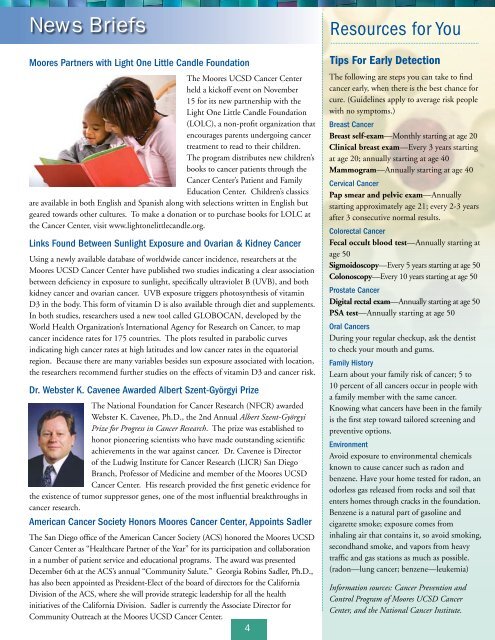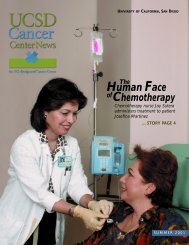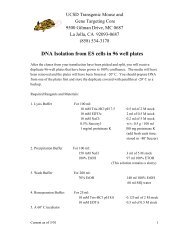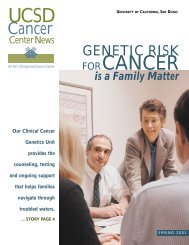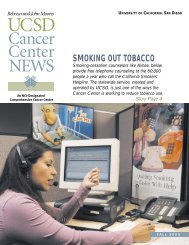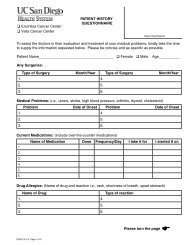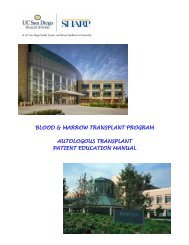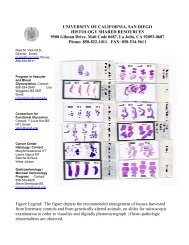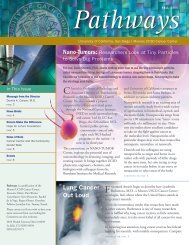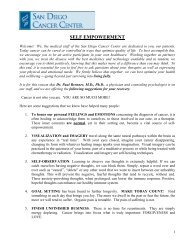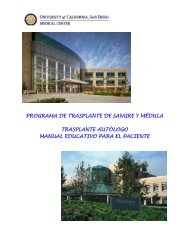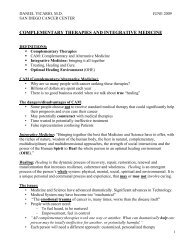The Science of Caring - Moores Cancer Center - UC San Diego
The Science of Caring - Moores Cancer Center - UC San Diego
The Science of Caring - Moores Cancer Center - UC San Diego
Create successful ePaper yourself
Turn your PDF publications into a flip-book with our unique Google optimized e-Paper software.
News Briefs<strong>Moores</strong> Partners with Light One Little Candle Foundation<strong>The</strong> <strong>Moores</strong> <strong>UC</strong>SD <strong>Cancer</strong> <strong>Center</strong>held a kick<strong>of</strong>f event on November15 for its new partnership with theLight One Little Candle Foundation(LOLC), a non-pr<strong>of</strong>it organization thatencourages parents undergoing cancertreatment to read to their children.<strong>The</strong> program distributes new children’sbooks to cancer patients through the<strong>Cancer</strong> <strong>Center</strong>’s Patient and FamilyEducation <strong>Center</strong>. Children’s classicsare available in both English and Spanish along with selections written in English butgeared towards other cultures. To make a donation or to purchase books for LOLC atthe <strong>Cancer</strong> <strong>Center</strong>, visit www.lightonelittlecandle.org.Links Found Between Sunlight Exposure and Ovarian & Kidney <strong>Cancer</strong>Using a newly available database <strong>of</strong> worldwide cancer incidence, researchers at the<strong>Moores</strong> <strong>UC</strong>SD <strong>Cancer</strong> <strong>Center</strong> have published two studies indicating a clear associationbetween deficiency in exposure to sunlight, specifically ultraviolet B (UVB), and bothkidney cancer and ovarian cancer. UVB exposure triggers photosynthesis <strong>of</strong> vitaminD3 in the body. This form <strong>of</strong> vitamin D is also available through diet and supplements.In both studies, researchers used a new tool called GLOBOCAN, developed by theWorld Health Organization’s International Agency for Research on <strong>Cancer</strong>, to mapcancer incidence rates for 175 countries. <strong>The</strong> plots resulted in parabolic curvesindicating high cancer rates at high latitudes and low cancer rates in the equatorialregion. Because there are many variables besides sun exposure associated with location,the researchers recommend further studies on the effects <strong>of</strong> vitamin D3 and cancer risk.Dr. Webster K. Cavenee Awarded Albert Szent-Györgyi Prize<strong>The</strong> National Foundation for <strong>Cancer</strong> Research (NFCR) awardedWebster K. Cavenee, Ph.D., the 2nd Annual Albert Szent-GyörgyiPrize for Progress in <strong>Cancer</strong> Research. <strong>The</strong> prize was established tohonor pioneering scientists who have made outstanding scientificachievements in the war against cancer. Dr. Cavenee is Director<strong>of</strong> the Ludwig Institute for <strong>Cancer</strong> Research (LICR) <strong>San</strong> <strong>Diego</strong>Branch, Pr<strong>of</strong>essor <strong>of</strong> Medicine and member <strong>of</strong> the <strong>Moores</strong> <strong>UC</strong>SD<strong>Cancer</strong> <strong>Center</strong>. His research provided the first genetic evidence forthe existence <strong>of</strong> tumor suppressor genes, one <strong>of</strong> the most influential breakthroughs incancer research.American <strong>Cancer</strong> Society Honors <strong>Moores</strong> <strong>Cancer</strong> <strong>Center</strong>, Appoints Sadler<strong>The</strong> <strong>San</strong> <strong>Diego</strong> <strong>of</strong>fice <strong>of</strong> the American <strong>Cancer</strong> Society (ACS) honored the <strong>Moores</strong> <strong>UC</strong>SD<strong>Cancer</strong> <strong>Center</strong> as “Healthcare Partner <strong>of</strong> the Year” for its participation and collaborationin a number <strong>of</strong> patient service and educational programs. <strong>The</strong> award was presentedDecember 6th at the ACS’s annual “Community Salute.” Georgia Robins Sadler, Ph.D.,has also been appointed as President-Elect <strong>of</strong> the board <strong>of</strong> directors for the CaliforniaDivision <strong>of</strong> the ACS, where she will provide strategic leadership for all the healthinitiatives <strong>of</strong> the California Division. Sadler is currently the Associate Director forCommunity Outreach at the <strong>Moores</strong> <strong>UC</strong>SD <strong>Cancer</strong> <strong>Center</strong>.4Resources for YouTips For Early Detection<strong>The</strong> following are steps you can take to findcancer early, when there is the best chance forcure. (Guidelines apply to average risk peoplewith no symptoms.)Breast <strong>Cancer</strong>Breast self-exam—Monthly starting at age 20Clinical breast exam—Every 3 years startingat age 20; annually starting at age 40Mammogram—Annually starting at age 40Cervical <strong>Cancer</strong>Pap smear and pelvic exam—Annuallystarting approximately age 21; every 2-3 yearsafter 3 consecutive normal results.Colorectal <strong>Cancer</strong>Fecal occult blood test—Annually starting atage 50Sigmoidoscopy—Every 5 years starting at age 50Colonoscopy—Every 10 years starting at age 50Prostate <strong>Cancer</strong>Digital rectal exam—Annually starting at age 50PSA test—Annually starting at age 50Oral <strong>Cancer</strong>sDuring your regular checkup, ask the dentistto check your mouth and gums.Family HistoryLearn about your family risk <strong>of</strong> cancer; 5 to10 percent <strong>of</strong> all cancers occur in people witha family member with the same cancer.Knowing what cancers have been in the familyis the first step toward tailored screening andpreventive options.EnvironmentAvoid exposure to environmental chemicalsknown to cause cancer such as radon andbenzene. Have your home tested for radon, anodorless gas released from rocks and soil thatenters homes through cracks in the foundation.Benzene is a natural part <strong>of</strong> gasoline andcigarette smoke; exposure comes frominhaling air that contains it, so avoid smoking,secondhand smoke, and vapors from heavytraffic and gas stations as much as possible.(radon—lung cancer; benzene—leukemia)Information sources: <strong>Cancer</strong> Prevention andControl Program <strong>of</strong> <strong>Moores</strong> <strong>UC</strong>SD <strong>Cancer</strong><strong>Center</strong>, and the National <strong>Cancer</strong> Institute.


